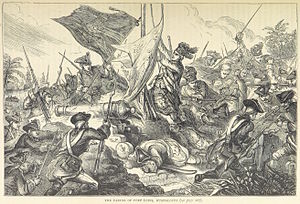Battle of Guadeloupe (1759)
| Invasion of Guadeloupe | |||||||
|---|---|---|---|---|---|---|---|
| Part of Seven Years' War | |||||||
 A British illustration of the capture of Fort Louis |
|||||||
|
|||||||
| Belligerents | |||||||
|
|
|
||||||
| Commanders and leaders | |||||||
|
Peregrine Hopson John Barrington |
Nadau du Treil Maximin de Bompart |
||||||
The British expedition against Guadeloupe was a military action from January to May 1759, as part of the Seven Years' War. A large British force had arrived in the West Indies, intending to seize French possessions. After a six-month-long battle to capture Guadeloupe they finally received the formal surrender of the island, just days before a large French relief force arrived under Admiral Maximin de Bompart.
Though the island was eventually ceded back to the French, the capture of the island contributed to the Annus Mirabilis of 1759.
To divert French troops from Germany, William Pitt decided the British should attack France wherever they could.
British troops were sent on diversionary attacks on the French coast, at St. Malo and Cherbourg. An expedition to western Africa captured the French slaving station at Senegal. In North America, a force was dispatched to take Louisbourg and Quebec.
In India Robert Clive won the Battle of Plassey.
For 1759, Pitt directed attention to the West Indies, specifically Martinique and Guadeloupe.
Major-General Peregrine Hopson, who had been Governor at Nova Scotia before the outbreak of war, was appointed to the chief command, and Colonel John Barrington, a junior officer, was selected to be his second.
On 12 November 1758, the transports, escorted by 8 ships of the line under Commodore Hughes, got under way and sailed with a fair wind to the west.
On 3 January 1759, the British expedition reached Barbados where Commodore John Moore was waiting with two more ships of the line to join it and to take command of the fleet. The total expeditionary force numbered some 6,800 men.
...
Wikipedia
